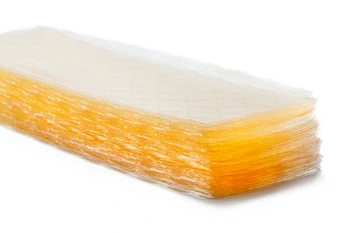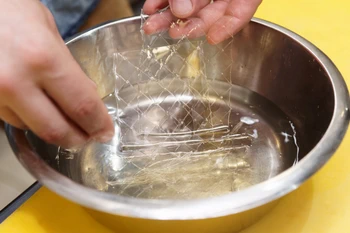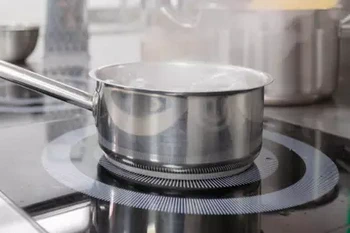This site uses only a few technical cookies necessary for its operation. By continuing to browse, you accept their use.
To find out more...
To find out more...
No need to boil gelatin

Gelatin is a magical ingredient for making light, creamy, structured desserts, yet it's often misused in the kitchen.
A common mistake in some recipes is the idea that it needs to be boiled for it to work properly, but this is a mistake indeed: gelatin melts at a much lower temperature, around 40°C.
Find out why this precision is essential, and how you can easily incorporate it into your preparations.
A common mistake in some recipes is the idea that it needs to be boiled for it to work properly, but this is a mistake indeed: gelatin melts at a much lower temperature, around 40°C.
Find out why this precision is essential, and how you can easily incorporate it into your preparations.
8,303 5/5 (1 reviews)
Keywords for this post:GelatinTemperatureMeltingMeltGelling agentLast modified on: November 21th 2024
No need to boil gelatin

What is gelatin?
Gelatin is a protein derived from collagen, widely used for its gelling properties in desserts such as mousses, entremets, panna cotta and bavarois. When used correctly, it provides a delicate, melt-in-the-mouth texture.
But its effectiveness depends on one golden rule: don't boil it. Indeed, gelatin dissolves perfectly in a hot liquid from 40°C, but if heated above 60°C, its gel-forming properties begin to break down.
Bringing the preparation that will contain it to the boil is therefore a rather bad idea, risking compromising the final texture of your desserts.

How do I use it?
Drain the gelatin sheets, softened by soaking in cold water, and add them directly to a warm-hot mixture (40-50°C).
If your recipe calls for a hotter mixture, add the gelatine off the heat to prevent overheating.
Once the gelatine has been incorporated, leave your dessert to cool in the fridge for the magic to happen (the gelatine sets).
Setting time varies according to recipe, but generally allow 2 to 4 hours.

Mistakes to avoid
- Boiling gelatin: As explained, this reduces its gelling capacity.
- Adding it directly to a cold mixture: It will not dissolve properly and may form lumps.
- Using the wrong quantity: Each recipe specifies the optimum dose, often around 2 g gelatin per 100 ml liquid for a classic texture.
In short: Forget recipes that require you to bring gelatin to the boil, a reasonable hot temperature is enough to reveal its potential, for perfect desserts and a consistently successful texture.
Lasts posts
Butter vs. grease
We often read in a recipe where a pastry is put into a mould that, just before pouring, the mould should be buttered or greased. But what's the difference between these 2 terms?December 1st 20251,0385
Getting out of the fridge early
Very often when you're cooking, you need to take food or preparations out of the fridge, to use them in the recipe in progress. There's nothing tricky about this: you just take them out of the fridge and use them, usually immediately, in the recipe. But is this really a good method?November 24th 20251,1415
Who's making the croissants?
When you look at a bakery from the outside, you naturally think that in the bakery, the bakers make the bread, and in the laboratory, the pastry chefs make the cakes. It's very often like that, with each of these professions having quite different ways of working, but sometimes there's also one...November 23th 20251,031
Oven height
When we put a dish or cake in the oven, we naturally tend to put it on the middle shelf, and that's what we usually do. But in some cases, this position and height can be a little tricky, so let's find out why.October 8th 20252,8085
The importance of sieving
In recipes that use a fine powder (flour, powdered sugar, etc.), you'll often see the advice to sift before using it. To sift is to pass the powder in question through a sieve (a very fine strainer) before incorporating it into your recipe. It's often advice, but is it really useful?September 3rd 20257,5663
Other pages you may also like
Tranché, dissociated, failed, in short... missed!
When preparing a sauce or a cream, there's always a (small) risk that the creamy preparation you're working on will suddenly separate into two parts of different textures: a liquid part, for example, and a more or less solid part, or even become lumpy. It's terribly frustrating, but we'll see...June 19th 202313 K5
Candied fruits: don't get ripped off
Do you like candied fruit? You might like to nibble a handful or add it to a recipe, like a classic fruit cake or delicious Italian specialities like panettone or sicilian epiphany pie.June 21th 201767 K 24.2
The so-called "nervous" meats
You've probably heard this before, we're talking about "nervous" meat, or meat with nerves, to describe what is indicated by the blue arrow on the left. This is a piece of beef, and what we call a nerve is not a nerve, it is in fact collagen (chemists sometimes call it a "collagen sink"), a...April 16th 202137 K4.5
What is the difference between bakery and patisserie?
This is a question that you may well have asked yourself and which I will attempt to answer. In France the two trades of "boulangerie" (bakery) and "pâtisserie" (patisserie and confectionery) have always been quite distinct, but where exactly do the boundaries lie? .February 7th 2017134 K 14.1
A few tips for effective kneading at home
When you have to knead dough for bread or some other recipe, you may well use a food processor or the type of machine known as a stand mixer. The best-known brands are Kenwood and KitchenAid. They are useful tools, but here are a few tips to help you get the best out of them.June 23th 2021284 K 23.8
Post a comment or question
Follow this page
If you are interested in this page, you can "follow" it, by entering your email address here. You will then receive a notification immediately each time the page is modified or a new comment is added. Please note that you will need to confirm this following.
Note: We'll never share your e-mail address with anyone else.
Alternatively: you can subscribe to the mailing list of cooling-ez.com , you will receive a e-mail for each new recipe published on the site.









